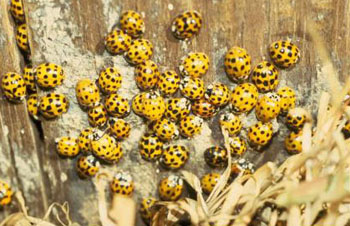Lady beetles have long been viewed as good bugs. Most people
aren’t scared of them, and very few want to kill them with insect
spray. But that’s quickly changing.
Each winter, more and more Asian lady beetles, often called
ladybugs, travel into homes seeking shelter from the cold. Cute
or not, these uninvited houseguests are outstaying their welcome
and ruining their reputations to boot.
Asian lady beetles are one of several species in Georgia. But
they’re the only one here with the annoying houseguest habit.
Universal feel-good bug
“Lady beetles are the universal feel-good bug, so it’s
unfortunate a few are becoming pests,” said Kris Braman, an
entomologist with the University of Georgia College of
Agricultural and Environmental Sciences.
A researcher whose work focuses on integrated pest management,
Braman has long supported lady beetles as beneficial insects.
They feed on aphids, an insect that can cause major damage to
pecan trees, crepe myrtles, roses and many other plants.
When lady beetles are around to eat the aphids, homeowners may
not need to spray insecticides to kill aphids, Braman said.
“Unfortunately, I’m not getting calls from homeowners who are
praising lady beetles for controlling aphids,” she said. “I’m
getting calls from people who are vacuuming up Shop-Vacs full of
lady beetles out of their homes.”
Seal up the entrance
Braman says the key to keeping them out of your home is finding
how they’re getting in and sealing the opening.
“Sometimes this is easier said than done,” she said. If the bugs
are able to get in, though, there are openings for heating or
cooling losses that should be attended to.
If you have to resort to physical removal, Braman urges you to
be careful. Lady beetles do have a defense mechanism.
“They can release yellow hemolymph, which is reflexive bleeding
from their joints,” she said. “It’s a defensive response for you
that can result in orange stains on your walls and furniture.”
So how does an insect make the bad, pesty bug list? It’s up to
us humans.
“Paper wasps are beneficial insects that feed on caterpillars
that damage crops like cotton and soybeans,” Braman said.
“They’re also the wasps that build their nests in the eaves of
our houses and sting if you get too close.”
No one thinks about the beneficial side of paper wasps when
they’re applying Sting-A-Way first aid treatment and spraying
streams of insecticide on their nests, she said.
“You just dub them a pest because they’re a bother to you, your
family and your home,” Braman said.
They aren’t cute on the ceiling
The pesty side of lady beetles is the aggravation they cause
when they come inside and the time it takes to remove them, dead
or alive. And when they die indoors from lack of food and water,
they contribute to household dust and debris.
“Living lady beetles don’t contribute to indoor air pollution,”
said Nancy Hinkle, a UGA Extension entomologist. “But dead
beetles should be regularly swept or vacuumed, because as their
bodies decompose they contribute to household dust.”
They’re no more likely than any other component of house dust
(pollen, molds, dust mites, feathers, dander) to contribute to
allergies, she said.
Lady beetles can bite, too.
“It’s just a little pinch,” Hinkle said. “Their mouthparts
aren’t really big enough to get much skin. But it’s uncomfortable
enough to be annoying.”
Hinkle said she has more than a thousand lady beetles living in
her own house. “I think my house is the main overwintering site
in north Georgia,” she said.
“When I read at night, the light burning over my bed lures in
every lady beetle in my house,” she said. “This is frustrating,
but not enough to persuade me to use insecticides. But I do look
forward to them moving out in the spring.”




